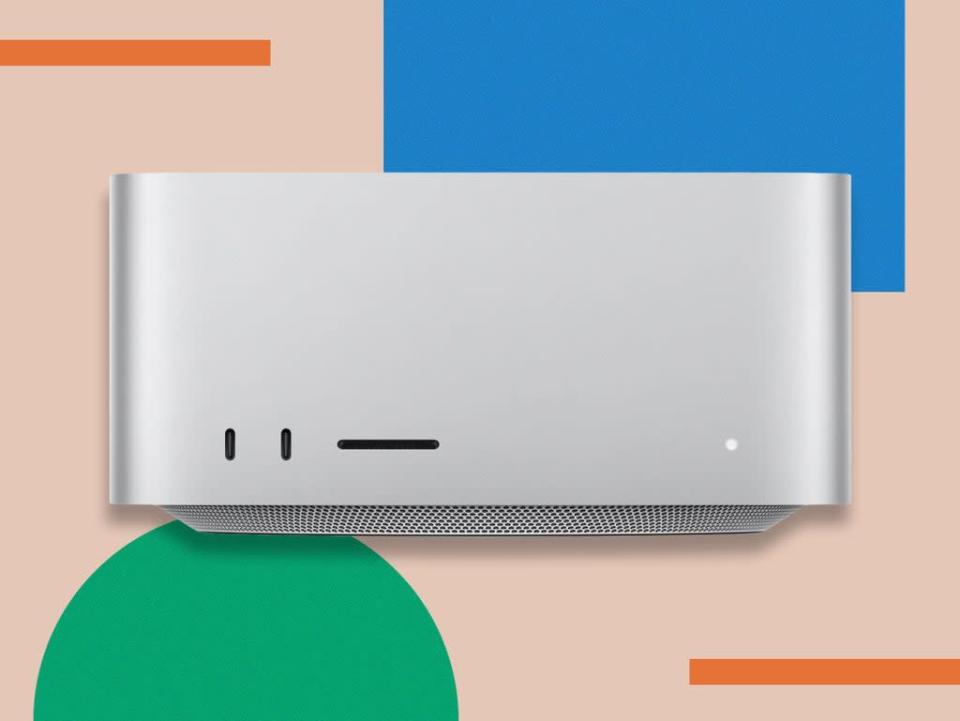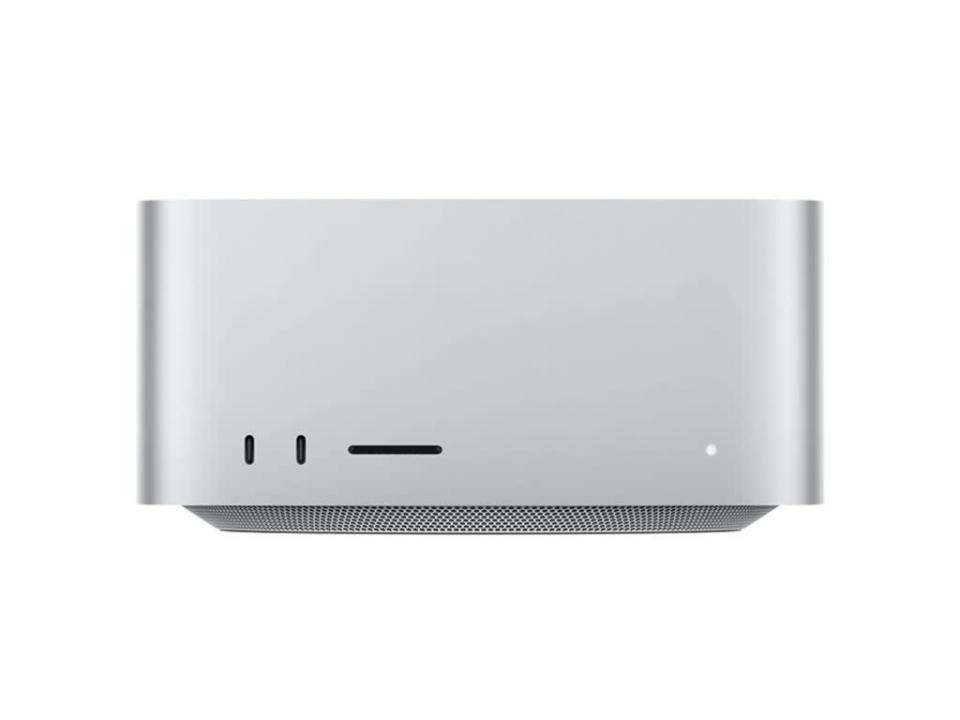[ad_1]

The Mac studio is the most powerful and capable computer Apple has ever built. At times, using it feels literally astonishing, when you realise that such great power is coming out of such an unprepossessing box.
It is also a whole new kind of computer for the company. Until now, its desktop line-up has offered thin, sleek iMacs and Mac minis (£622.97, Amazon.co.uk) for consumers alongside the big Mac pro (£5,499, Apple.com) for professionals – but in some ways the Mac studio is the very best of the two, being both powerful and small.
It has been able to make a computer like that because it has created a whole new way of building its computers, too, by putting its own chips inside. That means they can be smaller and faster than ever, and that Apple can design them from the very smallest transistor to the Mac studio’s imposing aluminium shell.
It all comes together to make a computer that answers almost every demand of Apple’s high-end users, and could launch whole new ways of using the Mac. It is the computer that professionals have been dreaming of for years: the Mac studio lives up to those fantasies.
At the same time, however, the studio is a highly specialised piece of kit – one that’s likely to be too powerful (and too expensive) for most people who just need something for email, browsing and word processing.
Read more:
It might just be the best computer Apple has ever made. And most people probably shouldn’t get it.
How we tested
We’ve been using the new Mac studio for a week, for both normal daily tasks and a variety of tests intended to push it to the limits of its performance. Throughout, we took note of how quickly and reliably it performed, as well as how it was to use as a daily computer. It was plugged into Apple’s studio display (£1,499, Apple.com), which was announced at the same time and is reviewed here.
You can pre-order the Apple Mac studio (£1,999, Apple.com) until Friday 18 March.
Apple Mac studio: £1,999, Apple.com – preorder now

Rating: 10/10 (for the right person)
-
Chip: M1 Max or M1 Ultra, with a 10- or 20-core CPU and 24- or 48-core GPU
-
Memory: 32GB-128GB
-
Storage: 1TB-8TB
-
Connections: Six USB-C ports, two USB-A ports, ethernet, power, HDMI, headphone jack and SD card slot
-
Height: 9.5cm x 19.7cm x 19.7cm
-
Weight: 2.7kg (max) or 3.6kg (ultra)
Design
Perhaps unusually for Apple, the Mac studio is not all that beautiful from the outside and, even more unexpectedly, it doesn’t seem to want to be. Breaking with history, the Mac studio clearly puts function over form, and is designed to work well rather than look good.
That doesn’t mean that it is ugly – far from it. It still has all the classy materials you’d expect from an Apple product, as seen in its rough aluminium and the tiny, regular holes in the back for blowing out air.
It just means that Apple, when faced with the choice between aesthetics and practicality, has clearly started to opt for the latter. For starters, there are ports in the front – two USB-C ones and an SD card reader – which mean that the front is busier but also far more useful.
Read more: How to choose the best Apple laptop for you
On the back there are even more ports, with a grand total of 10 holes, which include two USB-A ports (those connectors are more than 25 years old and feel positively geriatric). It is a welcome sign that Apple has realised that people still use them, however, and that they are incredibly useful even if they do also look a little clunky.
The overall design of the Mac studio embodies the same philosophy too. It is taller than you might like it to be, and generally larger, which means that it feels hefty, like a 3kg stone. It’s almost twice as heavy as last year’s fairly similar MacBook pro models, but is certainly still light enough to carry between different parts of an office, for instance. It is almost the opposite of the thin, tapered lines of, for example, the MacBook air, which is so small and neatly designed that you can almost cut yourself on it. And that’s for the best, given that the use cases are so different.

Its look is most similar to the Mac mini, and it is really just that computer but made much taller, with most of the extra space given over to cooling capabilities to keep the powerful chip from getting too hot. It’s a fitting design for a computer that is astonishingly hefty and useful on the inside, too. Compared with the supercar-like design of something like the iPad, the Mac studio is a truck – a very powerful, astonishingly capable truck.
Performance
Inside that large, silver box sits the real heart of the Mac studio: the chip. Apple first started making its own processors for its Macs in 2020, first revealing them in its consumer computers, and they have been getting more powerful ever since.
The studio features the most powerful version of those Apple silicon chips yet. Two options are available: the M1 max, which was already blazingly fast, and the M1 ultra, which is effectively two of those M1 max chips attached together so seamlessly that it literally just doubles their performance. (Confusingly, the M1 max is clearly not the maximum.)
The M1 max arrived along with the M1 pro in the newly redesigned MacBook pro last year. The Mac studio is the debut of the M1 ultra. You can choose which chip you like, with the max version costing £1,999 and the ultra costing £3,999.
Read more: Microsoft surface laptop studio review
We reviewed the M1 max version of the studio, but it was still able to take almost everything that was thrown at it. You could play with up to nine different 8K video streams at once; it was able to take a seemingly infinite number of tracks in Logic; it could display detailed 3D models and hardly flinch. It was actually difficult to get the computer to work hard enough to know where its limit might be.
Sometimes, in testing, we would forget what we were up to, and accidentally leave one of these experiments open while getting to work on another – meaning that the computer was not only dealing with multiple video streams in Final Cut Pro, for instance, but also huge projects in Logic or flipping through high-res photos in Adobe Lightroom so quickly they looked like a film. The Mac studio didn’t really seem to care, and never reminded us by slowing down that it was dealing with two or even three impossibly large projects.
In benchmarks such as those offered by Geekbench, the performance of the Mac studio under review was largely similar to the MacBook pro with the same chip. But the Mac studio offers the ability to do that for longer, given its extra cooling capabilities – it is also cheaper, with the M1 max MacBook pro starting at £3,299, though, of course, it has the benefit of coming with a display.

While this testing was all done on the M1 max, there is no reason not to believe Apple’s claims that, since the ultra is just the M1 max twice over, the performance will just be doubled too. It hasn’t exaggerated about these processors yet, and usually tends to understand their true prowess.
Some of these tests seem a little ridiculous – it’s unlikely that even many high-end professionals are going to be stressing their systems like this. But the performance is ridiculous too, and if nothing else it means you can be confident when you add a new video stream or do more detailed 3D graphics work that the computer has the headroom to be able to support it.
But, at the same time, all of that performance isn’t going to be necessary for most people. Apple has named the new “studio” perfectly, because this is a computer built for going inside those spaces: design studios, film studios, music studios, architecture studios, as well as high-end medical or scientific facilities. (It’s good that Apple has moved away from “pro”, which once really meant professional but now seems to just mean “nice”, as in the AirPods pro and iPhone pro.)
Read more: 8 best Chromebooks for Android smarts in a speedy laptop
If you aren’t expecting to be using this computer in demanding situations like that, then the prowess of the Mac studio is simply going to be too much. And that’s fine – not least because Apple offers the Mac mini, which includes the cheaper and a little slower but still fully capable M1 chip, and which looks a little nicer too.
But the kinds of people and workflows that need a computer like this have been crying out for it, for years. And now it has finally arrived, answering almost every question and fulfilling almost every dream.
The verdict: Apple Mac studio
The Mac studio is finally the Mac that can do almost everything, and which almost everyone doesn’t need. That is no bad thing: it is unashamedly high-end, and accordingly high-performance.
It is a computer that many people would have no real reason to buy, simply because it is far too powerful for their needs. But it’s likely to be the computer that makes the games, films, music and more that everyone is enjoying in the future.
For those who do need it, it’s a dream come true, and the performance that Apple has promised is entirely real. The brand has embraced the idea of creating something truly powerful – and here it is, in all of its surprising, joyful, capable, speedy and a-little-bit-ugly glory.
Apple Mac studio
Buy now £1999.00, Apple.com
Voucher codes
For the latest computer, laptop and tablet discounts, try the links below:
From Apple to Huawei, check out the best high-end laptops for great performance with sleek design
[ad_2]
Source link










More Stories
Hate speech on Twitter is at its lowest level, down even from pre-spike levels says Elon Musk- Technology News, Firstpost
Building Intelligent Document Processing Systems
Introduction to Building Intelligent Document Processing Systems – Grape Up